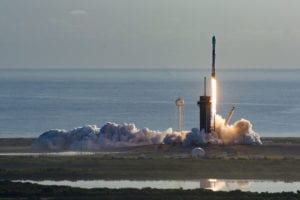
SpaceX launched its sixth Starlink mission at 8:16 a.m. EDT (12:16 UTC) on 18 March 2020. The Falcon 9 launch vehicle lifted off from Launch Complex 39A (LC-39A) at NASA’s Kennedy Space Center in Florida, US.
SpaceX CEO Elon Musk said the Falcon 9 experienced the loss of one of its nine engine during the trip to space, but still delivered its payload of 60 Starlink satellites into orbit.
“There was also an early engine shutdown on ascent, but it didn’t affect orbit insertion,” Musk posted on Twitter after the launch. “Shows value of having 9 engines! Thorough investigation needed before next mission.”
The attempt to land the Falcon 9’s first stage in the Atlantic Ocean on SpaceX’s drone ship “Of Course I Still Love You” failed.
“Our first stage successfully separated from the second stage, but unfortunately we did get confirmation that we were not able to land that first stage today,” SpaceX manufacturing engineer Jessica Anderson said during the live launch commentary. “While that was disappointing, she added, but the primary Starlink mission went on as planned.”
Falcon 9’s first stage previously supported the Iridium-7 NEXT mission in July 2018, the SAOCOM 1A mission in October 2018, the Nusantara Satu mission in February 2019, and the second launch of Starlink in November 2019. Falcon 9’s fairing previously supported the first launch of Starlink in May 2019.
The Starlink satellites were deployed in an elliptical orbit approximately 15 minutes after liftoff. Prior to orbit raise, SpaceX engineers conducted data reviews to ensure all Starlink satellites were operating as intended. Once the checkouts were complete, the satellites used their onboard ion thrusters to move into their intended orbits and operational altitude of 550 km.
SpaceX is leveraging its experience in building rockets and spacecraft to deploy the world’s most advanced broadband internet system. With performance that far surpasses that of traditional satellite internet and a global network unbounded by ground infrastructure limitations, Starlink will deliver high speed broadband internet to locations where access has been unreliable, expensive, or completely unavailable.
Each Starlink satellite weights approximately 260 kg and features a compact, flat-panel design that minimizes volume, allowing for a dense launch stack to take full advantage of Falcon 9’s launch capabilities. With four powerful phased array and two parabolic antennas on each satellite, an enormous amount of throughput can be placed and redirected in a short time, for an order of magnitude lower cost than traditional satellite-based internet.
Starlink satellites are on the leading edge of on-orbit debris mitigation, meeting or exceeding all regulatory and industry standards. At end of their life cycle, the satellites will utilize their on-board propulsion system to deorbit over the course of a few months. In the unlikely event their propulsion system becomes inoperable, the satellites will burn up in Earth’s atmosphere within 1-5 years, significantly less than the hundreds or thousands of years required at higher altitudes. Further, Starlink components are designed for full demisability.
Starlink is targeting service in the Northern U.S. and Canada in 2020, rapidly expanding to near global coverage of the populated world by 2021.
 SpaceWatch.Global An independent perspective on space
SpaceWatch.Global An independent perspective on space




